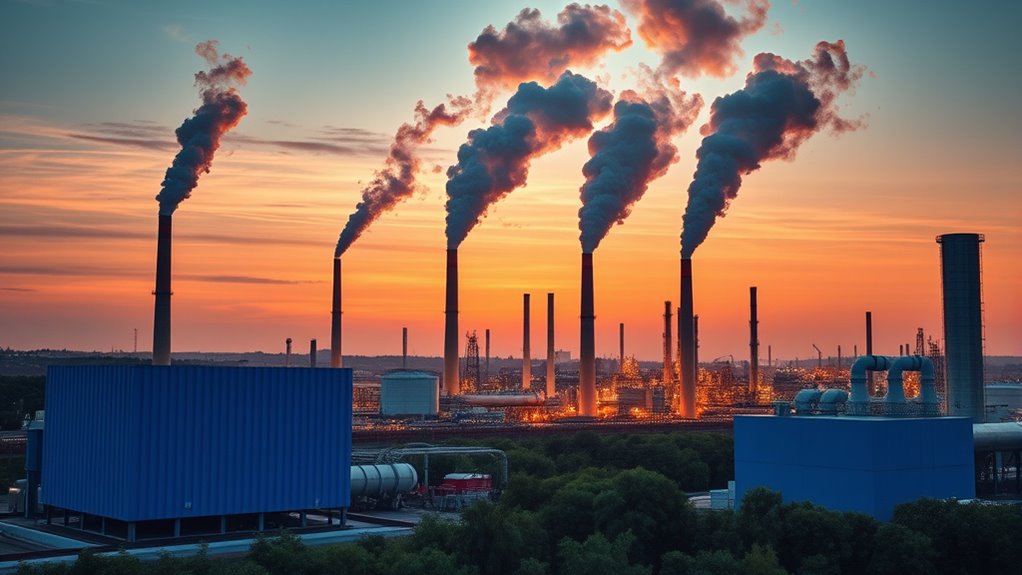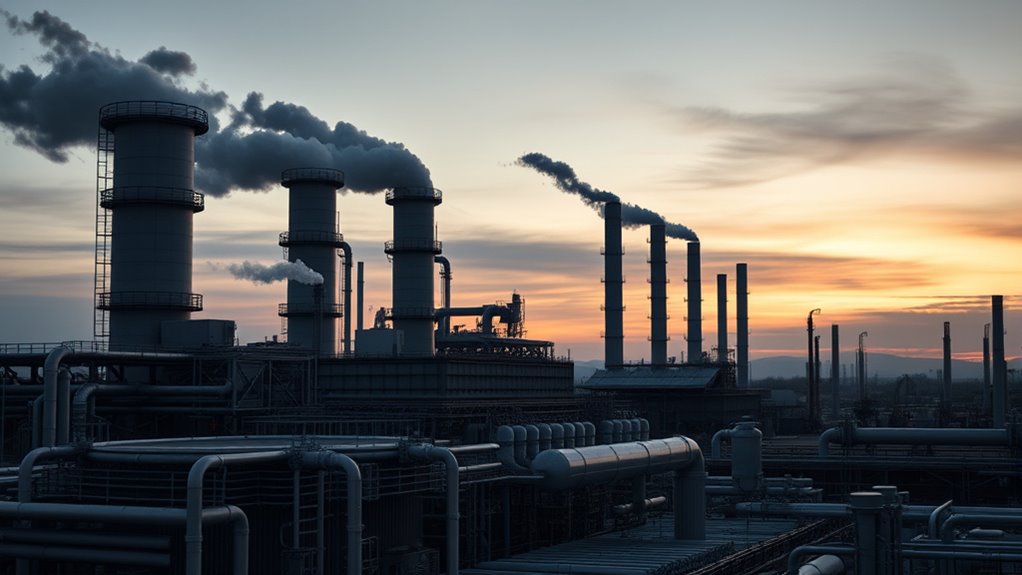To tackle VOCs and particulate emissions, you need to implement effective control strategies like activated carbon adsorbers, thermal oxidizers, and biofilters at emission sources. Optimizing process design, adding scrubbers, and recovering solvents help reduce pollutants. Regular maintenance and real-time air monitoring guarantee systems work efficiently. By adopting these measures, you protect air quality and meet regulations. To discover more practical solutions and innovative approaches, keep exploring how you can improve your facility’s emission management.
Key Takeaways
- Implement source capture systems like activated carbon adsorbers and thermal oxidizers to efficiently remove VOCs and particulates.
- Optimize manufacturing processes and use cleaner materials to reduce emissions at the source.
- Regularly maintain and monitor emission control devices to ensure optimal performance and regulatory compliance.
- Incorporate solvent recovery systems and low-emission technologies to minimize VOC release and promote sustainability.
- Use real-time air quality monitoring and supplementary ventilation to detect pollutants quickly and improve indoor air environments.

Have you ever wondered what keeps industries running smoothly? It’s often the behind-the-scenes efforts to control emissions and guarantee compliance with environmental standards. Two critical aspects in this process are VOC control and emission mitigation. Volatile Organic Compounds (VOCs) are common pollutants released during manufacturing, painting, and chemical processing. Left unchecked, these emissions can cause air quality issues, health problems, and regulatory penalties. That’s why industries prioritize VOC control — to reduce the amount of these compounds released into the atmosphere. Implementing effective VOC control strategies involves using advanced technologies like activated carbon adsorption, thermal oxidizers, and biofilters. These systems capture VOCs at the source, preventing their escape into the air and minimizing environmental impact. Emission mitigation, on the other hand, encompasses a broader approach that targets various pollutants, including particulate matter, gases, and aerosols. It involves designing processes to reduce emissions early in production, optimizing operational parameters, and installing emission control devices.
You’ll find that industries often combine multiple methods to achieve ideal results. For example, using scrubbers to remove particulate matter and gases, along with VOC-specific control systems, enhances overall air quality. Regular maintenance and monitoring are essential to guarantee these systems operate efficiently and meet regulatory standards. Emission mitigation isn’t just about installing equipment; it’s about creating a thorough strategy that includes process modifications, cleaner production techniques, and continuous environmental performance assessments. This proactive approach helps industries stay ahead of tightening regulations and reduces their environmental footprint. Additionally, incorporating air quality monitoring enables industries to track pollutant levels in real-time and respond swiftly to any deviations. Regularly checking air quality indices can inform necessary actions to improve indoor and outdoor air quality. Understanding the sources of pollutants helps in choosing the right purification strategy. Combining air purifiers with good ventilation practices enhances overall air quality and effectiveness.
You might also explore innovative solutions like solvent recovery systems, which reclaim VOCs for reuse, or developing low-emission materials that inherently produce fewer pollutants. Training staff on best practices and environmental awareness ensures that everyone contributes to emission reduction efforts. Emphasizing a culture of continuous improvement means your facility can adapt to new technologies and stricter standards over time. In essence, tackling VOCs and particulate emissions is an ongoing process that demands vigilance, investment, and innovation. By prioritizing VOC control and emission mitigation, you actively protect air quality, safeguard public health, and support sustainable industry growth. This commitment not only benefits the environment but also enhances your facility’s reputation and operational resilience. Ultimately, it’s about creating a safer, cleaner future — one emission at a time.
Frequently Asked Questions
How Do VOC Emissions Vary Across Different Industrial Sectors?
You’ll find that VOC emissions vary across industrial sectors mainly due to different VOC sources and emission patterns. For example, chemical manufacturing and paint production release high levels of VOCs, while food processing has lower emissions. Understanding these patterns helps you target specific sources effectively. By monitoring emission trends, you can implement tailored controls, reducing VOCs and improving air quality across diverse industries.
What Are the Latest Innovations in Emission Control Technologies?
You won’t believe how advanced filtration and chemical scrubbers are revolutionizing emission control! These innovations can snatch VOCs and particulates from the air with unparalleled efficiency, turning pollution into pure, clean air almost instantly. Cutting-edge filtration systems use nanotech to trap even the tiniest particles, while chemical scrubbers neutralize harmful gases on contact. This tech is transforming industries, making pollution control more powerful, faster, and more effective than ever before!
How Do Regulations Differ Internationally for Industrial Emissions?
You’ll find that international standards vary, with regions like the EU enforcing strict regulations like the Industrial Emissions Directive, while the US relies on EPA standards. To stay compliant globally, you should develop robust compliance strategies that adapt to each jurisdiction’s rules. Monitoring local regulations helps you avoid penalties, and aligning your emission controls with international standards guarantees smoother operations across borders, reducing environmental impact and boosting your reputation.
What Are the Long-Term Health Effects of VOC Exposure?
You might experience long-term health effects from VOC exposure, including chronic respiratory issues and neurological impacts. Prolonged contact can lead to persistent breathing problems, such as asthma or bronchitis, and may also affect your nervous system, causing headaches, dizziness, or cognitive difficulties. To protect yourself, avoid prolonged exposure and follow safety guidelines, especially if working in environments with high VOC levels, and seek medical advice if you notice symptoms.
How Can Facilities Monitor Emissions in Real-Time Effectively?
You can monitor emissions effectively by installing air quality sensors that provide real-time data on VOCs and particulates. Make certain to integrate these sensors with data analytics platforms, which help you identify patterns and potential leaks quickly. Regular calibration and maintenance are essential to guarantee accuracy. Additionally, setting up automated alerts allows you to respond promptly, minimizing environmental impact and ensuring compliance.
Conclusion
Just like a ship steering through stormy seas, managing VOCs and particulate emissions requires steady hands and vigilant eyes. When one factory installed advanced filters, emissions dropped by 60%, transforming their operations into a cleaner, safer environment. Remember, your efforts can be the lighthouse guiding your facility toward sustainability. By tackling these pollutants head-on, you steer your operations away from danger and toward a brighter, healthier future for all.









